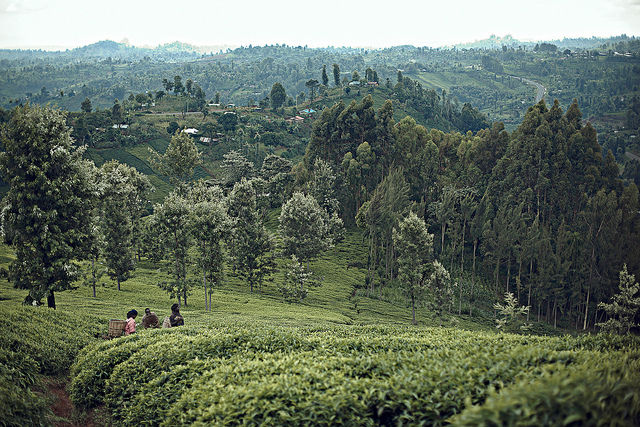Like this article? rabble is reader-supported journalism. Chip in to keep stories like these coming.
Over the weekend a memorial was unveiled to victims of British colonial violence in Kenya. Paid for by London, the monument in Nairobi grew out of London’s 2013 apology to the Mau Mau, which included some compensation to 5,000 victims of British policy who pursued justice in London court.
Britain’s small step towards atoning for its colonial past is an opportunity to explore Canada’s contribution to this brutal period, which was an offshoot of Ottawa’s long-standing endorsement of colonialism Africa.
In 1952, the Kikuyu, Kenya’s largest ethnic group, launched an anti-colonial struggle and over the next eight years the British would employ horrific violence in a bid to suppress what became known as the “Mau Mau Uprising.” The British detained most of the 1.5 million Kikuyu in camps and fortified villages. Thousands of prisoners were tortured to death or died from malnutrition and disease and in some camps most children perished. Tens of thousands of Kenyans were killed by British forces.
Compared to the vast African loss of life, only 32 European civilians among the 30,000 white settlers were killed by the Mau Mau. More settlers died in car accidents during this period. The British and Canadian press, however, focused their coverage on lurid stories detailing purported Mau Mau violence. On a number of occasions, the uprising in Kenya was brought up in the Canadian House of Commons, but External Affairs Minister Lester Pearson said little.
As they unleashed terrible violence in Kenya, Ottawa strengthened the British military, which had been weakened during the Second World War. In 1953, Canada gave the Royal Air Force 370 “top-of-the-line” F-86 Sabre fighter Jets built at Canadair’s plant in Montreal. The planes cost $71 million ($600 million today) with the U.S. footing 30 per cent of the bill.
Several squadrons of Royal Air Force bombers dropped 50,000 pounds of bombs on Mau Mau forest hideouts. It’s almost certain that some of the British pilots were trained in Canada as part of the Second World War British Commonwealth Air Training Plan and the post-1949 NATO Air Training Plan, which saw the Royal Canadian Air Force train 5,500 pilots and navigators largely from Britain and France.
Some 55,000 British troops fought in Kenya, along with many battalions of the King’s African Rifles from other parts of East Africa. They employed a great deal of weaponry, some of which originated in Canada. In the last decade of European colonialism in Africa, Canada delivered a huge amount of weaponry to the colonial powers through NATO’s Mutual Aid Program. Between 1950 and 1958, Ottawa donated $1.53 billion ($8 billion today) in “aid” to NATO countries. The deliveries included anti-aircraft guns, military transport vehicles, ammunition, minesweepers, communications and electronic equipment, armaments, engines and fighter jets.
Canada also had men on the ground involved in the colonial violence in Kenya. Former RCMP officer John Timmerman served as assistant commissioner of police in Kenya during the Mau Mau insurgency. Between 1951 and 1955, Timmerman helped reorganize the police force and oversaw Nairobi’s Criminal Investigation Department (CID). In October 1952, Timmerman oversaw the arrest of Jomo Kenyatta, who would later become Kenya’s independence leader.
A July 1954 Ottawa Citizen article headlined “Terror Shadows Kenya Beat” reported “a Canadian just back from three years’ police work among the Mau Mau of Kenya says the terrorists are the most savage and bestial killers in the world.” Timmerman’s claim may represent what a Freudian psychologist would call a “projection.” Kenyan historian Bethwell Allan Ogot puts forth a different — and considering what’s been abundantly documented — more plausible account of the RCMP officer’s actions. “Beating of suspects to obtain evidence was rampant especially in Nairobi where Mr. John Timmerman, the notorious C.I.D. Chief (the Himmler of Kenya as he was called) and his henchman G. Heine presided over the torture chambers.” In Imperial Reckoning Caroline Elkins also compares the CID to the secret police in Nazi Germany and German-occupied Europe. “The Criminal Investigation Department… were effectively the colony’s Gestapo, according to one member of the force.”
At CID-operated centres, a favoured interrogation method was to hold a man upside down with his head in a bucket of water and ram sand into his rectum. In a bid to spread fear, men were raped with knives, snakes and scorpions while women were gang-raped or had their breasts mutilated with pliers.
A former white settler who was a member of the Kenya Regiment explained:
“We would go and pick up a few of the filthy pigs and bring them to one of the interrogation centers set up by the CID. These were the hard-core scum, the ones who wouldn’t listen to anyone and [were] causing trouble. So we would give them a good thrashing. It would be a bloody awful mess by the time we were done. … never knew that a Kuke [Kikuyu] had so many brains until we cracked open a few heads.”
While Timmerman carried out British policies, his post-Kenya rise through the ranks suggests his actions found support in Ottawa. A Canadian Intelligence Corps officer in Europe prior to Kenya, afterwards Timmerman led the security and intelligence liaison at External Affairs, which included the politically sensitive task of making sure External Affairs officials were not spying or acting on behalf of foreign states. Then Timmerman became the first RCMP officer ever appointed head of a Canadian mission, serving as consul general in Chicago in the 1970s.
Should Canada apologize for its role in these atrocities?
Author of the just-released Canada In Africa: 300 years of aid and exploitation, Yves Engler will be speaking across the country in the lead-up to the election. For information: Yvesengler.com
Photo: Mary Beth Koeth/flickr
Like this article? rabble is reader-supported journalism. Chip in to keep stories like these coming.



